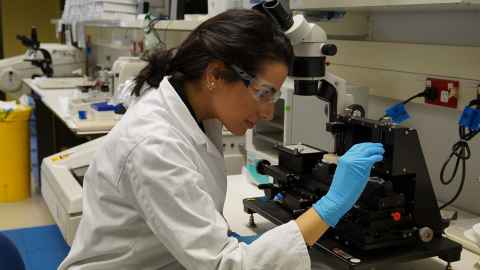Tissue Screening Facility
The Tissue Screening Facility focuses on developing and using human brain tissue microarray technology to undertake research into brain disorders.

The tissue microarray (TMA), high throughput automated microscopy and high content screening (HCS) facility at the Centre for Brain Research was established and is directed by Professor Mike Dragunow. Funding for establishing the facility was initially obtained from the National Research Centre for Growth and Development/Gravida, Freemasons Mount Roskill, the Coker Charitable Trust, and Brain Research New Zealand.
The TMA/HCS facility is run in conjunction with the Neurological Foundation Human Brain Bank, the Hugh Green Biobank and Neurovalida and provides a high throughput facility for molecular pathological analysis of the human brain. Through Neurovalida, TMA and HCS are used to help Pharmaceutical and Biotech companies to validate their candidate drug targets in the human brain and in the disease of interest. This work contributes to the development of medications to treat brain disorders.
What is tissue microarray (TMA)?
TMA is a technique of arraying cores of tissue (in our case human brain tissue) into blocks that can then be cut and used for histological, immunohistochemical, immunofluorescence and in situ hybridization studies. For example, TMA designed to study Alzheimer’s disease (AD) comprise 30 cores of middle temporal gyrus (a region affected severely in AD) from AD donors and 30 cores from neurologically normal aged- and sex-matched controls. Thin sections of these arrays are then cut on a microtome and adhered to standard microscope slides and processed in many ways to compare expression of desired proteins in AD.
As only small cores are used, this TMA method saves on precious donated human brain tissue. Also, as a high number of cores from many donors can be studied in one slide, any differences between AD and controls are more likely to be discovered as there is very little experimental error involved.
What is automated scanning?
Once the slides are processed using a particular staining method, they are then put into an automated slide scanner. This scanner acquires images at high throughput and in an automated standardised fashion.
TMA images acquired on the VSlide scanner are then analysed using high content analysis/screening with the Metamorph (or other) high throughput image analysis software.
What is high content analysis/screening?
High content analysis/screening uses automated image analysis programs to extract simple or complex features from images at high throughput. For example, it can be used to count nuclei from cells for simple cell counts and complex features of nerve cells such as dendritic arborisation. It can also be used to quantify signal transduction processes in cells such as agonist-induced receptor internalisation, nuclear translocation of proteins and cytoplasmic versus nuclear localisation of proteins involved in brain diseases.
Essentially HCA/HCS does what our eyes and brain do but more accurately, more quickly, and in a standardised, objective manner. It allows researchers to put numbers to complex features that were previously only analysed qualitatively.
The Tissue Screening Facility is being used by staff and students of the CBR and other collaborators to study the causes of human brain disorders, and by Neurovalida scientists to identify and validate drug targets to promote the development of medications for these brain disorders.
Contact
Professor Mike Dragunow
Director, Tissue Screening Facility
Phone: +64 9 923 6403
Email: m.dragunow@auckland.ac.nz